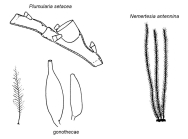
| Intro | | Search taxa | | Browse taxa | | Distributions | | Terminology | | References | | Statistics | | Online sources | | Tutorial | | Log in |
WoRMS taxon detailsPlumulariidae McCrady, 1859
1613 (urn:lsid:marinespecies.org:taxname:1613)
accepted
Family
Plumularidae McCrady, 1859 · unaccepted > misspelling - incorrect original spelling (incorrect name formation)
marine,
(of Plumularidae McCrady, 1859) McCrady, J. 1859. Gymnopthalmata of Charleston Harbor. Proceedings of the Elliott Society of Natural History 1: 103-221, pls 8-12. , available online at https://www.biodiversitylibrary.org/page/42536587
page(s): 198 [details]
Schuchert, P.; Choong, H.; Galea, H.; Hoeksema, B.; Lindsay, D.; Manko, M.; Pica, D. (2025). World Hydrozoa Database. Plumulariidae McCrady, 1859. Accessed through: World Register of Marine Species at: https://marinespecies.org/aphia.php?p=taxdetails&id=1613 on 2025-07-15
Date action by 2004-12-21 15:54:05Z created db_admin
Nomenclatureoriginal description
(of Plumularidae McCrady, 1859) McCrady, J. 1859. Gymnopthalmata of Charleston Harbor. Proceedings of the Elliott Society of Natural History 1: 103-221, pls 8-12. , available online at https://www.biodiversitylibrary.org/page/42536587 page(s): 198 [details] basis of record Calder D.R. (1997). Shallow-water hydroids of Bermuda: superfamily Plumularioidea. <em>Royal Ontario Museum Life Sciences Contributions.</em> 161: 1-86. page(s): 8 [details] Taxonomytaxonomy source
Hincks, Th., 1868. A history of the British hydroid zoophytes.London, John van Voorst. Volume 1 : i-lxviii + 1-338, volume 2: pls 1-67., available online at https://www.biodiversitylibrary.org/page/46798707 page(s): 279, emended spelling [details] Other Present Present  Inaccurate Inaccurate  Introduced: alien Introduced: alien  Containing type locality Containing type locality
From editor or global species database
Diagnosis Colonies erect, monosiphonic or polysiphonic, arising from creeping, rootlike, or disc-shaped hydrorhiza; hydrocauli branched or unbranched, hydrocladia alternate, opposite or in verticils, arising in polysiphonic hydrocauli from a single axial tube; hydrothecae typically small, uniseriate, usually at least partially adnate, occurring only on hydrocladia, with or without marginal cusps; nematophores with well developed nematothecae, not as naked sarcostyles; all nematothecae (axillar, cauline or hydrothecal) usually two-chambered (bithalamic) and movable, a minimum of three nematothecae adjacent to hydrothecae, one mesial inferior and a pair of lateral ones; gonophores as fixed sporosacs, exceptionally as swimming gonophores; gonothecae solitary, without nematothecae; with or without phylactocarps. [details]Spelling Spelling by Agassiz (1862: 358) was Plumularidae, Hincks (1868) introduced the correct spelling Plumulariidae. [details] |

